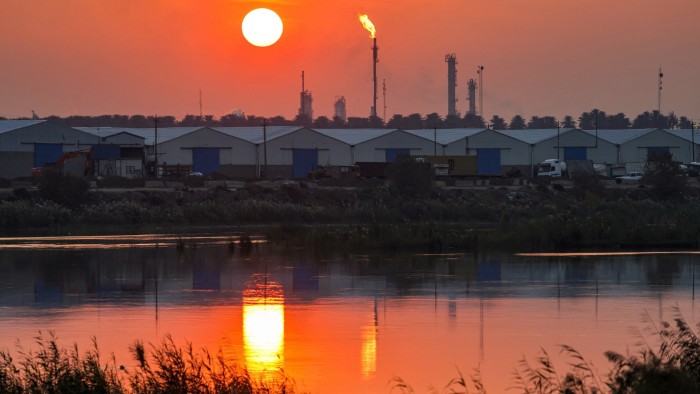Israel’s strikes against Iran have threatened to ignite a regional conflict that disrupts oil supplies across the Middle East, with traders reviving the decades-old question of whether Tehran could respond by closing the vital industry chokepoint at the Strait of Hormuz.
Brent crude, the global benchmark, surged 12 per cent to a high of $78.5 a barrel in the early hours of Friday morning after Israel launched dozens of strikes against Iran’s nuclear programme and military facilities, killing at least two top commanders.
Prices fell back to $74 a barrel as it became clear that Israel had stopped short of targeting Iran’s oil infrastructure, but traders said prices could move significantly higher depending on how Tehran retaliates.
“The market is reasonably calm because the Israelis chose not to target oil infrastructure, but if you’re Iran, you know that’s the Achilles heel,” said a senior executive at a major oil trading company, pointing to the risk that Tehran responds by attacking oil facilities in the Gulf or tankers in the Strait of Hormuz.
About 21mn barrels of oil from Iran, Iraq, Kuwait, Saudi Arabia and the United Arab Emirates pass daily through the narrow waterway separating the Islamic republic from the Gulf states, representing about a third of the world’s seaborne oil supplies.
Iran has repeatedly threatened to close the strait in the event of an attack but has never been able to block all traffic. Although it is a pinch point for flows of crude, the strait is still 35 miles wide at its narrowest point.
“A closure of the strait, though unlikely at this time, would represent the most extreme action Iran could take,” said Amena Bakr, head of Middle East and Opec+ at energy analytics group Kpler. “While US troops in the region would promptly react and reopen the strait, this would push Brent prices way above the $100 a barrel threshold.”
Given the presence of the US navy’s Fifth Fleet in Bahrain, Helima Croft, head of global commodity strategy at RBC Capital Markets, said it would be “extremely difficult” for Iran to close the strait completely for an extended period. Tehran could launch attacks on tankers to disrupt traffic, as it did during the Iran-Iraq war in the 1980s, she said. However, such a step would also disrupt the more than 1mn b/d that Iran exports to China.
When Iran and Israel exchanged air strikes in April and October 2024, it was Iran that struck first, with Israel retaliating.
“This time, the sequence has reversed — a shift that could significantly influence market expectations and risk perceptions,” said Jorge León, head of geopolitical analysis at energy consultancy Rystad. If Iran disrupts oil flows through the Strait of Hormuz, targets regional oil infrastructure or strikes US military assets, it could push prices up by “$20 per barrel or more”, he said.

Some of the world’s largest oilfields, including in Saudi Arabia and Iraq, are within reach of Iran’s missiles and drones. In 2019 Iran was widely believed to be behind a drone attack on Saudi Arabia’s largest oil processing facility that temporarily cut the kingdom’s crude production by more than half and briefly pushed up global oil prices by as much as 20 per cent.
However, the restoration of diplomatic ties between Riyadh and Tehran in 2023 has made a repeat attack on Saudi Aramco’s oil facilities less likely, according to Kepler’s Bakr. “The dynamics between Iran and Gulf states have changed over the past years,” she said.
An alternative scenario might see Israel escalate its assault by targeting Iran’s vital Kharg Island terminals, which are responsible for 90 per cent of the Islamic republic’s oil exports and the primary source of funds for its government and nuclear programme.
Traders said prices, which remain below levels earlier in the year before US President Donald Trump launched his blitz of global tariffs, would be much higher if markets became convinced that direct attacks on oil infrastructure were likely.
“The correct price for oil is almost certainly not where it is today,” the senior trading executive said. “The fundamentals [of supply and demand] tell you the price should be lower by $10 or more. The risk premium, if you need a risk premium, probably should be $10 higher.”
Before this week’s military escalation, oil prices had generally been falling since March, pushed lower by the expectation that Trump’s tariffs will hurt demand and the Opec+ cartel’s decision to accelerate the unwinding of long-standing production cuts.
The Saudi Arabia-led producer group has already agreed to restore up to 1.4mn barrels a day of idled capacity between April and July and is on course to increase the group’s headline production by another 800,000 b/d between August and September.
In the event of a major disruption, for example to Iranian supply, most traders expect Opec would move to increase production even faster. In theory, the group still has more than 5mn b/d in idled capacity to bring back online.
However, the group on Friday insisted it was too soon for any discussion of drawing from emergency stocks.
“[Opec] affirms that there are currently no developments in supply or market dynamics that warrant unnecessary measures,” it said in a statement.








